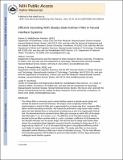Efficient Decoding With Steady-State Kalman Filter in Neural Interface Systems
Author(s)
Malik, Wasim Qamar; Truccolo, Wilson; Brown, Emery N.; Hochberg, Leigh R.
DownloadBrown-Efficient Decoding With Steady.pdf (1.131Mb)
OPEN_ACCESS_POLICY
Open Access Policy
Creative Commons Attribution-Noncommercial-Share Alike
Terms of use
Metadata
Show full item recordAbstract
The Kalman filter is commonly used in neural interface systems to decode neural activity and estimate the desired movement kinematics.We analyze a low-complexity Kalman filter implementation in which the filter gain is approximated by its steady-state form, computed offline before real-time decoding commences. We evaluate its performance using human motor
cortical spike train data obtained from an intracortical recording array as part of an ongoing pilot clinical trial. We demonstrate that the standard Kalman filter gain converges to within 95% of the steady-state filter gain in 1.5[plus-over-minus sign]0.5 s (mean[plus-over-minus sign]s.d.) . The difference in the intended movement velocity decoded by the two filters vanishes within 5 s, with a correlation coefficient of 0.99 between the two decoded velocities over the session length. We also find that the steady-state Kalman filter reduces the computational load (algorithm execution time) for decoding the firing
rates of 25[plus-over-minus sign]3 single units by a factor of 7.0[plus-over-minus sign]0.9. We expect that the gain in computational efficiency will be much higher in
systems with larger neural ensembles. The steady-state filter can thus provide substantial runtime efficiency at little cost in terms of estimation accuracy. This far more efficient neural decoding approach will facilitate the practical implementation of future
large-dimensional, multisignal neural interface systems.
Date issued
2011-02Department
Harvard University--MIT Division of Health Sciences and Technology; Massachusetts Institute of Technology. Department of Brain and Cognitive SciencesJournal
IEEE Transactions on Neural Systems and Rehabilitation Engineering
Publisher
Institute of Electrical and Electronics Engineers
Citation
Malik, W Q et al. “Efficient Decoding With Steady-State Kalman Filter in Neural Interface Systems.” IEEE Transactions on Neural Systems and Rehabilitation Engineering 19.1 (2011): 25–34. Web.
Version: Author's final manuscript
ISSN
1534-4320
1558-0210